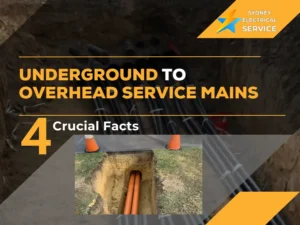Google Reviews ⭐⭐⭐⭐⭐

Table of Contents
- Introduction
- Understanding the Risks of Working Near Power Lines
- Rule #1: Maintain a Safe Distance
- Rule #2: Use the Right Equipment
- Rule #3: Implement a Safety Observer
- Rule #4: Plan Your Work
- Rule #5: Conduct a Risk Assessment
- Rule #6: Know the Emergency Procedures
- Rule #7: Obtain Necessary Permits and Approvals
- Rule #8: Conduct Regular Safety Training
- Frequently Asked Questions
- Understanding Sydney Electrical Service and our Level 2 Electrical Services
Working near power lines in New South Wales (NSW) carries inherent risks that can lead to severe or even fatal incidents without the proper precautions it is essential to understand the basics and always refer back to the Work Near Overhead Power Lines NSW Code of Practice whenever any work is intended to be carried out near power lines. Whether you’re a seasoned electrician, a tradesperson, or a homeowner looking to do some DIY work on your property, understanding and adhering to safety rules is non-negotiable. This guide outlines eight essential safety rules you must know to ensure a secure working environment near overhead and underground power lines in NSW.
Understanding the Risks of Working Near Power Lines
Before diving into the safety rules, let’s set the stage with an exciting hook: Imagine a regular day turning into a nightmare because of a moment’s distraction or a simple oversight near power lines. The consequences can be dire: from life-threatening injuries to costly damages. But here’s the good news: such scenarios can be preventable.
By following these eight safety rules, you’re not just complying with regulations; you’re safeguarding your life and those around you.
Rule #1: Maintain a Safe Distance
Maintaining a safe distance when working near power lines is the most critical rule to prevent electrical accidents. The exact distance depends on the voltage of the power lines, with higher voltages requiring greater distances. In NSW, guidelines suggest a minimum distance of 3 meters for voltages up to 132,000 volts, with increased distances for higher voltages. This rule applies to all parts of the body, tools, equipment, and vehicles. The principle behind maintaining a safe distance is to avoid the risk of electrical arcs that can jump across air gaps, potentially causing electrocution or fire.
Real-life example: A landscaper was trimming a tree near power lines without maintaining the safe exclusion zone. The branch fell onto the power lines, causing a power outage in the area and exposing the worker to a high risk of electrocution.

Rule #2: Use the Right Equipment
Using the right equipment means selecting tools and machinery that are specifically designed and rated for working near electrical installations. This includes using insulated tools for manual work, vehicles and machinery with appropriate insulation for electrical safety, and personal protective equipment (PPE) like insulated gloves and footwear that meet Australian Standards. Equipment should be regularly inspected and maintained to ensure it remains in good condition and safe to use near power lines.
Real-life example: An electrician used a non-insulated ladder while working near power lines, which came into contact with the lines. Fortunately, the electrician survived but suffered severe injuries.

Rule #3: Implement a Safety Observer
A safety observer is crucial when working near power lines, especially in situations where workers are at risk of coming into close proximity to electrical installations. The safety observer’s role is to monitor the work being carried out, ensure that safe distances are maintained, and alert workers if they are getting too close to power lines. This is particularly important for tasks that require concentration on the work at hand, making it easy to lose awareness of the surroundings.
Real-life example: During construction work near power lines, a safety observer alerted the crane operator just in time to prevent the crane from hitting the overhead lines, avoiding a potential disaster.

Rule #4: Plan Your Work
Planning work when working near power lines involves assessing the work area for electrical hazards before starting any job. This includes identifying the location of overhead and underground power lines, establishing safe work zones, and determining the safest methods for carrying out the work. Planning also involves considering the time of day and weather conditions, as these can affect safety when working near power lines.
Real-life example: A team failed to plan their work according to safety standards, leading to a digger striking an underground power cable, causing significant property damage and risking lives.
Rule #5: Conduct a Risk Assessment
A risk assessment is a systematic process to identify potential hazards when working near power lines and to evaluate the risks associated with those hazards. The assessment should consider the type of work being done, the tools and equipment used, the proximity to power lines, and the qualifications and experience of the workers. Based on the risk assessment, appropriate safety measures should be implemented to mitigate the identified risks.
Real-life example: Before commencing work, a risk assessment identified a high-risk area near power lines. This led to re-routing the work, significantly reducing the risk of an accident.
Rule #6: Know the Emergency Procedures
Knowing the emergency procedures is essential for responding effectively in case of an accident involving power lines. This includes knowing how to safely evacuate the area, how to call for emergency services, and how to administer first aid to someone who has been electrocuted. Workers should also be trained on how to extinguish electrical fires and on the use of emergency shutdown procedures for electrical equipment.
Real-life example: An emergency situation arose when equipment became entangled with power lines. Because the team was well-versed in emergency procedures, they quickly secured the area and contacted emergency services, preventing further hazards.
Rule #7: Obtain Necessary Permits and Approvals
Before starting work near power lines, it is important to obtain the necessary permits and approvals from the relevant authorities, including local electricity providers such as Endeavour Energy and Ausgrid. These permits ensure that the work is carried out safely and in compliance with all legal and regulatory requirements. They may also specify additional safety measures or conditions that must be followed during the work.
Real-life example: A contractor obtained the necessary permits for working near power lines, ensuring that all safety protocols were in place, which streamlined the project and avoided legal complications.
Rule #8: Conduct Regular Safety Training
Regular safety training ensures that workers are aware of the hazards associated with working near power lines and know how to work safely. Training should cover the specific risks of the job, the use of safety equipment, emergency procedures, and legal responsibilities. It should be conducted regularly to keep workers up-to-date with current safety standards, regulations, and best practices. Training is not only crucial for new employees but also as a refresher for experienced workers to reinforce safety awareness and compliance.
Real-life example: Regular safety training for a construction team paid off when a new worker identified a potential hazard near power lines that others had missed, reinforcing the value of continuous education.

FAQ’s

Understanding Sydney Electrical Service and our Level 2 Electrical Services
Ensuring work safety near power lines is not just about compliance; it’s about protecting lives and properties. At Sydney Electrical Service, we’re committed to providing top-notch electrical services with an unwavering focus on safety. Our team of licensed Level 2 electricians is equipped with the knowledge, expertise, and tools to handle all your electrical needs, especially if you’re experiencing issues with overhead powerlines, working near overhead power lines, or upgrading your existing powerlines to your residence.













